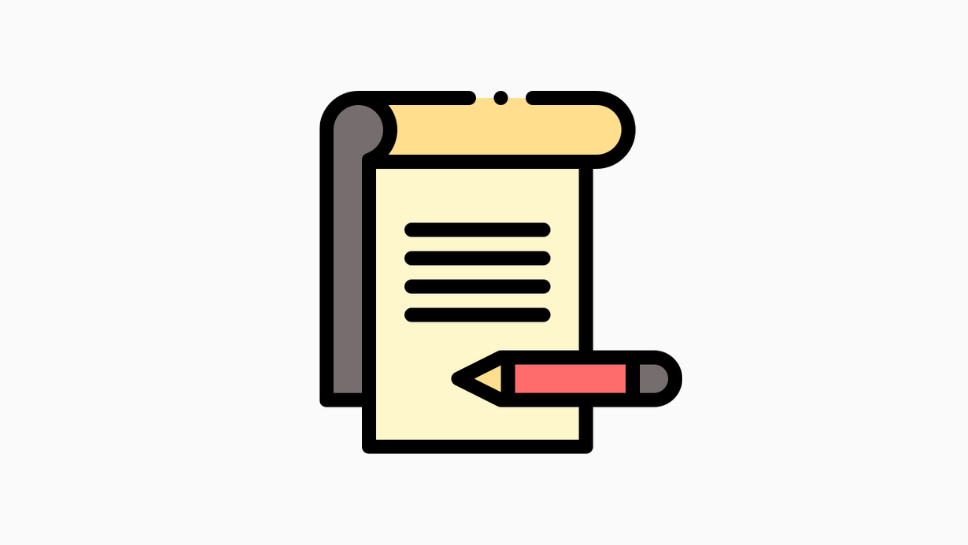Table of Contents
I’ve read literally every single study on note-taking to help law students learn more efficiently and effectively. And it turns out we’re all study wrong.
👨🌾 Hunter vs Farmer
Here’s the problem.
The way most of us approach note-taking goes a little like this: we turn up to our lectures, frantically try to write/type everything the lecturer is saying, and then leave feeling frustrated that we didn’t understand everything. So, we then pop to the library, having picked up our pumpkin spiced latte, obviously, and dive straight into the textbooks and journal articles, where we continue to flesh out and structure our lecture notes until we’ve got a million pages of notes covering every nook and cranny of that particular topic.
We may feel like we’ve got our head around things at this point, but the chances are we’re probably going to forget everything a couple days later and it’s all going to be pretty overwhelming come exam time.
This was exactly how I felt during my first year at uni, but I couldn’t quite put my finger on what the hell I was doing wrong. I was attending my lectures, doing all my reading, and creating the most complete set of notes I could for every. single. topic.
My flaw, it turns out, was I was taking notes as a hunter rather than a farmer. In other words, I was spending all my time hunting for all the information I needed, rather than actually cultivating my knowledge of the law and learning the stuff I needed to learn.
So, to explain why being a farmer is better than being a hunter, I want to quickly show you the science behind effective note-taking, before taking a closer look at the best way we should take notes at law school.
👯♂️ A False Dichotomy
When I started to read all the papers on effective note-taking, I noticed something pretty surprising – none of them actually bother to confirm whether or not taking notes is a good thing.
Instead, they’ve all just accepted the premise that taking notes is useful for some reason, without going into any further detail or giving a source for this. Then, from that unstable starting point, the studies just go on to analyse a very specific note-taking technique.
Basically, the studies do little to clear up what note taking techniques are best or to help us decide whether we should even bother with taking notes in the first place. So, it’s all pretty confusing.
For example, one of the most common techniques that these studies analyse is the question “is it better to take more notes or less notes?”. In other words, the classic quantity vs quality debate.
The Note-Taking Debate
On the face of it, it looks like taking lots of notes is the best technique.
Like, Kiewra’s study on “Note Taking Functions and Techniques” found that those students that took more notes typically performed better when later tested on the topic. The same conclusion was also reached by Bui, who split 76 students in a class in half, with one group focusing on the quantity of their notes and the other focusing on quality. When tested immediately after, those that wrote more notes during their class outperformed the group focused on quality.
But, these results don’t actually prove that taking more notes is better than taking quality notes.
For example, Kiewra’s study actually concludes that the useful thing about note-taking isn’t the amount of notes we take (i.e it’s not the note-taking process), but the reading of those notes. Basically, by taking more notes we have more to read, and the more we read on a topic before being tested on it the better we perform.
But, confusingly, the result of this study also doesn’t mean that reading our notes is a useful revision technique. All it’s saying is that taking lots of notes and reading those notes before some later test, is better than taking fewer notes under the same conditions.
Bui’s study is also problematic. It turns out that taking more notes tends to work best when tested immediately after, but is less effective than taking quality notes when there’s a delay before the test. And there’s a ton of other studies that back this up. Take, Roediger’s study on “The Power of Testing Memory”, for example – here we can very clearly see that the same study technique could be the best one to use when tested after 5 minutes, but literally the worst one ever when tested after a week:
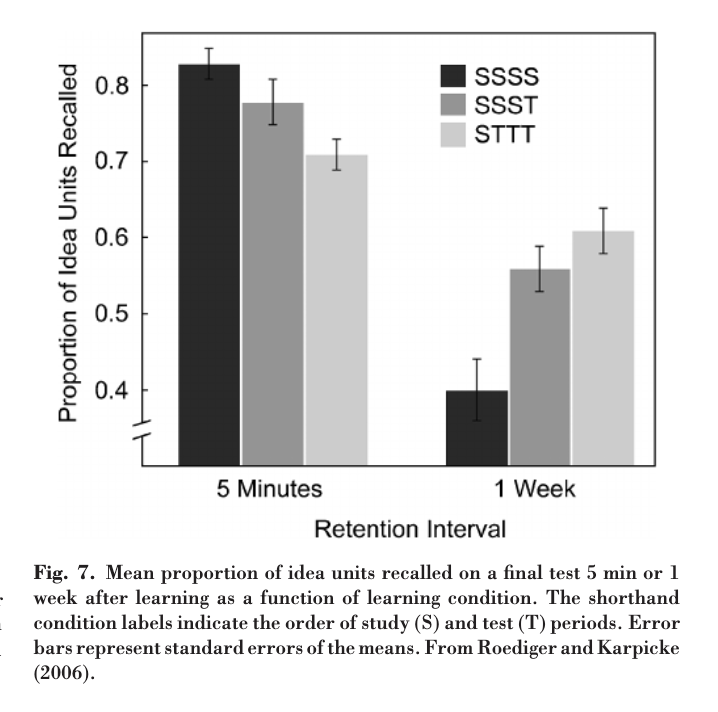
The important point to make here, then, is not that note-taking is bad, but that we need to be taking notes and using techniques based on our goals, which is typically going to be for some form of exam or assessment happening many days or weeks after we first learnt the information. This is precisely why we can’t just focus on hunting and transcribing all the information, but cultivating that knowledge like a farmer.
So, what can we learn from all these studies to help take notes more effectively as a law student?
📝 The SOAR Framework
What I’ve learnt is that there’s really three stages of note-taking we need to be aware of to optimise our learning of the law + cultivate that knowledge: 1) preparation 2) process and 3) product.
1. PREPARATION – The Foundation
First, we prepare ourselves for taking notes.
The idea here is that we should already have a structure of what our learning is going to look like before we begin taking any notes. The way I like to do this is – if I’m about to read something or go to a lecture – I’ll quickly write down the key headings and sub-headings for the topic I’m about to study. This gives me a brief overview of what to expect and allow me to see how each piece of information I learn fits into the bigger picture.
Like, let’s say I’m about to attend a lecture or read something on the content requirements of an easement, I’d probably write down the four requirements from the Ellenborough Park judgement as my headings with space between each topic heading for me to add notes:
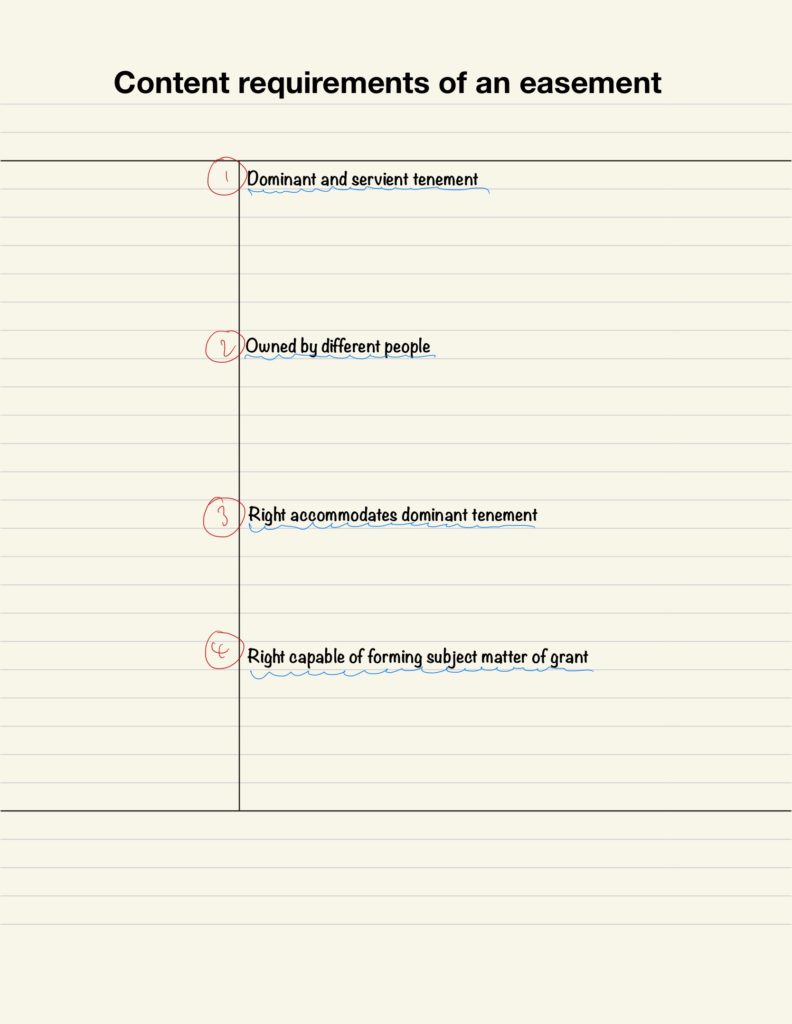
If we’ve got time, we should also try to read a quick summary of the topic before we dive into the process of taking the notes as this primes us for effective note-taking and become familiar with key concepts in advance.
This whole process takes about 10 minutes to do and makes the process of actually taking notes so much more effective.
2. PROCESS – Non-Linear Notes
Cognitively, note-taking depends upon working memory, which is used for both comprehension (i.e. attention and understanding of a topic) and production (i.e. identifying important content and physically generating notes).
Due to the limited capacity of our working memory, we’re only ever really able to focus one thing or the other (Piolat et al., 2005) i.e. understand the topic or make notes on the topic. This leads most students to either focus on writing everything down or writing almost nothing at all, both of which are sub-optimal for long-term learning.
So, what’s the solution?
The solution is to find a note-taking strategy that strikes a balance between comprehension and production, which leads me on to the Cornell method – a note-taking technique designed to boost focus, capture key insights, and produce critical thought at the same time.
And they basically do this through their structure. On the right side of the page we’ve got the headings we created in the previous step, which is where we want to capture the key insights. I’m talking like 1-3 bullet points per heading. Then, on the left, we use this space for critical thoughts, keywords, and questions we have that we want to explore after class. Finally, at the bottom, we’ve got some space to summarise our notes in a couple of sentences:
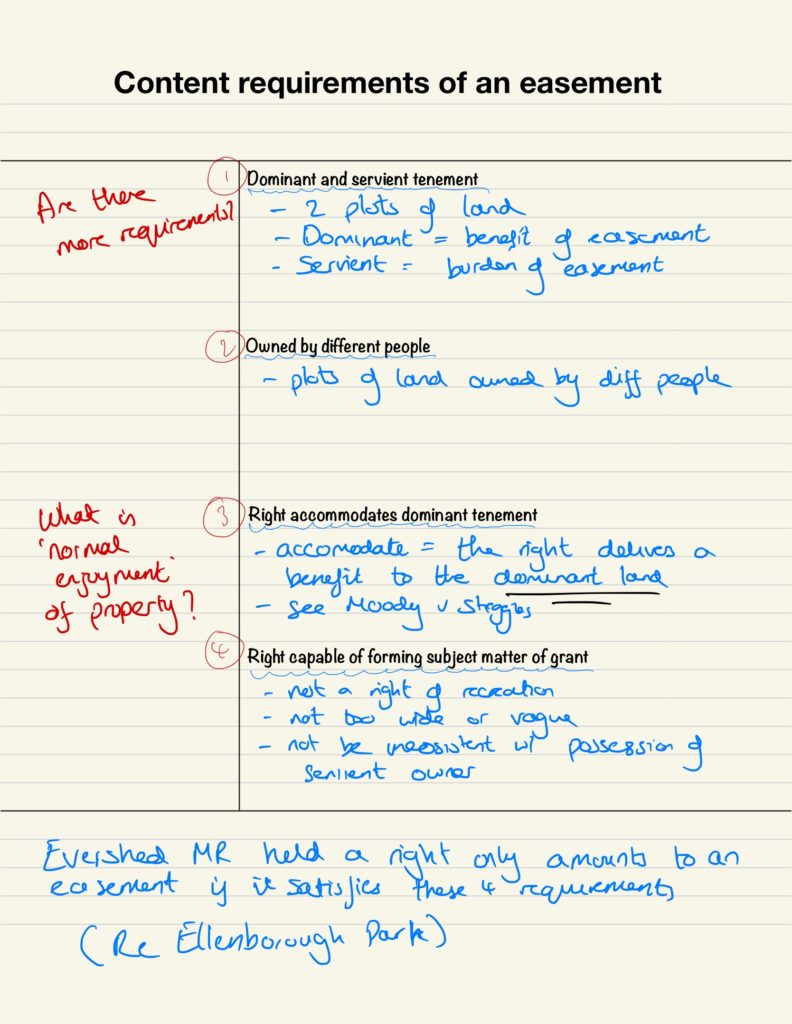
I love this method of taking notes because it makes lecturers and reading learning-focused, which is the ultimate goal of taking notes at uni.
3. PRODUCT – The SOAR Framework
Finally, once we’ve taken our initial notes using the Cornell method we can employ the SOAR framework – which stands for summarise, organise, analyse, and review – to take our learning to the next level.
1. Summarise – we begin by writing out everything we remember of the topic, using our notes as a guide. Doing this within a few hours of taking our initial notes is key, due to Ebbinghaus’ forgetting curve, which basically tells us that reviewing notes soon after we first learn something significantly improves our long-term retention of that topic.
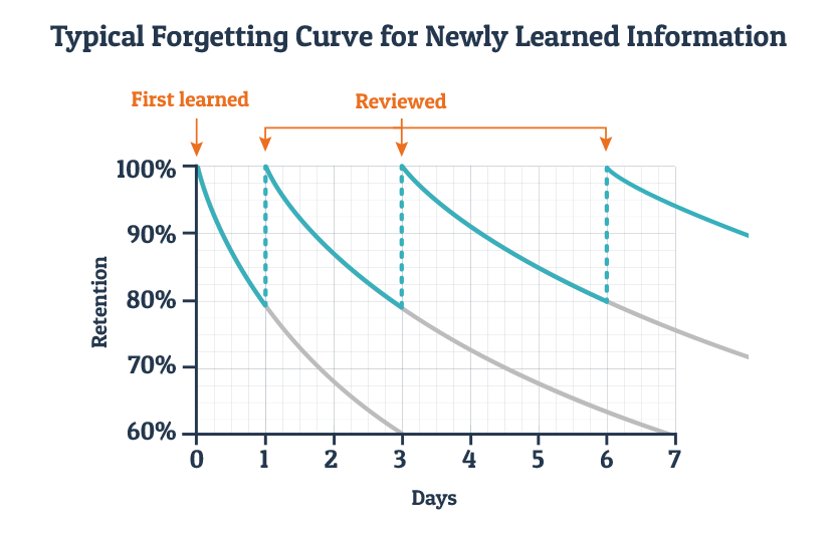
2. Organise – over the next couple of days, we need to organise those notes into a sensible structure and flesh it out using textbooks, journal articles, and case summaries. In an ideal world, we’d have one comprehensive set of notes that we can use to review the topic in depth (i.e. quantity), but also have a series of less detailed notes (i.e. quality) that can be used for quick revisions. This is something called progressive summarisation, which I’ve talked about in an article I wrote on Digestible Notes.
3. Analyse – this step is about taking our notes from a second class level to a first class level, and it’s where we inject critical analysis into our notes. Basically, try to say what things you agree or disagree with, draw comparisons to other areas of the law, and form an opinion on stuff.
4. Review – this leads us on to the final step of the SOAR framework, which is ‘review’. The reason we take notes is usually so we can review them and learn them for exams and things like that, so we need to structure our notes to help that process. One really effective method for reviewing notes is though retrieval practice or self-testing, which is something I’ve written about in my article on how I memorised everything at law school. But, in essence, we want to create questions using flashcards or some similar process that we can use to regularly test ourselves on the content, helping us to identify our weaknesses and where we need to flesh out our notes.
So, that pretty much summarises how I go about taking notes and turning them into something I can revise from 🙂

